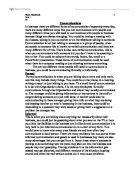Verbal is communicated by people talking to each other, it is done through telephone messages or recorded messages using answering machines and voice mail. Although verbal information can be obtained quickly it often needs backing up in written form. For example, when you communicate an important message to a work colleague he or she might also say ‘could you also email me about that’ or ‘please can I have that in writing?’
Written information will cover a range of paper documents that are exchanged within an organisation. Written information takes time to process and often requires extensive filing and distribution systems
Electronic information is rapidly replacing other forms of communication. Most large organisations use an internal networking system. Nearly all networks have an email facility, and this is used to send documents in electronic form around a company.
External communication
Organisations need to communicate with a range of stakeholders, including shareholders, customers, government officials, suppliers and the community. A range of different external communications media can be used to communicate with the above people.
These communications perform a number of functions:
- A public relations function. To present a good image of the company.
- An informative function. To provide various groupings with essential information about the company.
- A day-to-day trading function. To transact the business’s daily commercial relationships.
- A transparency function. Today, it is often important that outsiders can see what is happening inside the organisation so they know the company is carrying out its business in a true and fair way.
Formal an Informal Communications
Formal communication in an organisation is communication that takes place through the recognised channels. Informal communications are ones that take place that are not part of the officially recognised networks of the organisation. This does not mean informal communications are necessarily negative or anti-organisational. Indeed, organisational members taking initiative into their own hands and coming up with ideas that directly benefit the organisation carry much of the good work in organisations out. Informal communications can also serve as motivating forces because they are based on individual initiative.
Upward and Downward
Much of the communication in old fashioned, traditional industries was carried out in downward direction. Managers created the systems, the rules and the work programmes and communicated these down the line to junior employees.
There are advantages to this:
- Senior managers are able to set targets and objectives, and then give the instructions to make sure they are carried out.
- Because there is a clear line of command, instructions can be clear and consistent.
- Costs can be cut by operating with an efficient system in which fewer errors are made.
However, in recent years, there has been more of an emphasis on upward communication. This is important because:
- Good ideas can bubble up from below from people who deal with ‘nuts and bolts’ situations on a day-to-day basis.
- Many people at the bottom of an organisation are very talented and have good ideas that are worth listening to.
- Managers can be made aware of likely problems before they occur.
- It provides feedback on the decisions being made by senior managers.
- People lower down the organisation are more likely to know what is practical in a working setting than those higher up.
- Being asked to be involved in the communication process motivates those lower down in the organisation.
Open or restricted channels
With any form of communication it is important to identify the purpose of the message as well as the people at whom the message is to be targeted. If the message is targeted at everyone within the organisation or groups outside and does not contain confidential materials, then the message is open for anyone to see or intercept.
On the other hand, if the message contains confidential materials, the likelihood is it will be targeted at only a few groups of users, either within a particular department or at certain levels of seniority, so that its use is restricted.







